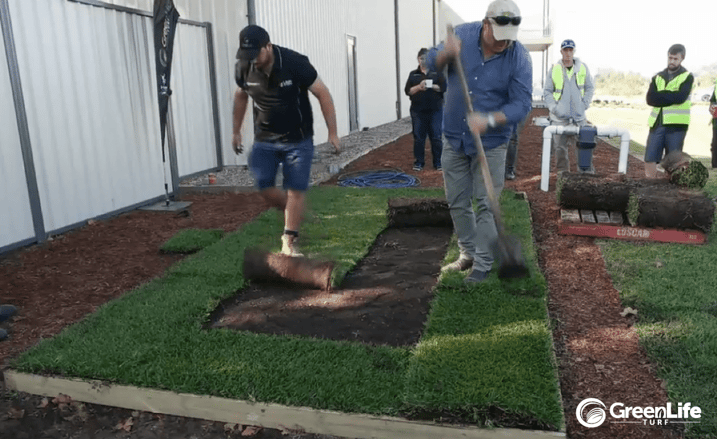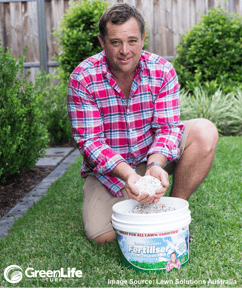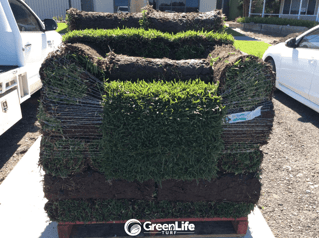 Yes, that's Jason Hodges helping out on the Green Life Turf farm!
Yes, that's Jason Hodges helping out on the Green Life Turf farm!
There’s a right way and many wrong ways to do almost anything, and when it comes to laying new turf, it’s no exception.
Today we’re talking about the right way to lay new lawn. It's filled with lots of don't-miss tips so get yourself a coffee and let's go!
You’ve already made one of the most important decisions in this process: choosing the right variety of lawn for chosen the right variety of lawn for your lifestyle and area (environment).
Let’s start from here:
How to Lay Turf
Step 1. Clean Up
Start by removing all existing vegetation like weeds and old grasses. Spray them with a herbicide like Roundup two weeks or more before you begin preparing your soil, and dig them out to remove all traces. Re-spray them a second time if needed.
Step 2: Ground Excavation
It’s time to level off your soil to the right height.
A good rule of thumb is to excavate about 25mm – 40mm below where you want your lawn to sit so that the top of your lawn sits fairly level to paths, driveways, etc. Consider the layers you’ll be putting underneath your turf in your measurements (for example, any topsoil, etc).
Give your soil a light rake and look for high and low spots. Rake out the high areas, and fill in the low areas.
 Step 3: Measure Your Area & Order Your Turf (and any topsoil and starter fertiliser)
Step 3: Measure Your Area & Order Your Turf (and any topsoil and starter fertiliser)
With your area clear, you can now easily measure out your area. For more tips on how to measure your area, head here: “How to Measure your Area for Turf”.
With that measurement, you're ready to go ahead and order your turf and underlay and starter fertiliser required.
Handy Tip: When ordering your turf for delivery, choose a day that fits in with when you plan to lay your turf.
Step 4: Prepare Your Soil
“Lawn is only as good as the soil you’re laying it on.” You need deep strong roots for a successful lawn.
- Assess & Repair – Assess the condition of your existing soil. Compacted lawns or lawns with a high clay content need a little extra help. Excavation and topsoil may help with compacted lawns, and agricultural gypsum will break down clay if necessary.
- Loosen Existing Soil – Use a rotary hoe or shovel to loosen up soil that is in good condition.
- Topsoil – If your soil is in poor condition, cannot be loosened up easily or has a high clay component, or if you just want to make sure it has the best soil available, apply a good topsoil mix like Turfgro Premium Turf Underlay to give your lawn th
 e perfect soil to grow in. Apply topsoil about 100mm deep.
e perfect soil to grow in. Apply topsoil about 100mm deep. - Perfect Soil Compaction – Soil should be soft enough to see a shoe-print, but not so soft as to see the indent from the sides of your shoe. If it’s too compact, go back and loosen with rotary hoe or spade. If it’s too loose and fluffy, roll it down a little with a roller.
- Starter Fertiliser – Evenly apply a starter fertiliser with moisture magnets (we like Sir Launcher which is easy to apply by hand or using a hand spreader), then lightly rake it in.
Step 5: Laying Your New Turf
When to Lay Your Turf
Because grass is a living thing, needs nourishment to survive, and takes its food through its root system planted in soil, you need to lay your new turf as soon as possible after delivery.
If you’ve received a delivery from Green Life Turf, you can be sure that your turf has been freshly cut and will have a longer life out of the ground than turf that has been cut days earlier. But even so, that’s no reason to delay laying your turf for much longer – especially in warm or humid temperatures. If it’s going to be particularly hot on laying day, start early, get it laid, and get water onto it right away.
For more information about when to lay your turf, head here: "How Soon To Lay New Turf".
How to Lay Your Turf
- “Green side up.” 😉
- Begin at the edges and hard surfaces, laying full slabs in these areas as they are most robust during establishment and better equipped to handle these sorts of areas.
 Work backwards (begin the furthest away from where your unlaid turf rolls or slabs have been delivered). This will help you avoid walking on the newly laid turf which can be damaging.
Work backwards (begin the furthest away from where your unlaid turf rolls or slabs have been delivered). This will help you avoid walking on the newly laid turf which can be damaging.- Lay turf slabs next to each other so they are touching each other, without gaps, without stretching, and without overlapping.
- If your area is on a slope, lay turf slabs horizontally (across ways) to limit the risk of the slabs slipping down, especially in heavy rain.
- Lay slabs in a brickwork pattern.
- If you have an odd shaped area, after the edges are laid begin where a simple straight line of slabs can be laid with as many full slabs as possible. Once that’s done you can go back and fill in the areas.
- Once you lay a slab in position, gently step onto the connecting edges to bed the slabs in together.
- Once it's placed in position, cut any slabs that need trimming to fit into your area using a knife, garden shears or spade.
- Roll your new lawn with a roller; either once you're finished (for smaller areas) or as you go (or for larger areas.
- Water your lawn as soon as possible. This is SO important. At least 25mm of water within the first 30 minutes of installation is absolutely essential. If you’re not sure how much that is, just make sure your new lawn is saturated! For larger areas or in hotter weather, water as you go rather than once you're finished.
Step 6: Establishing Your New Lawn
- “Get off my lawn!” – That’s right, try to stay off your lawn, and keep the kids and pets off too, until your lawn is fully established.
- Watering during establishment – Water your beautiful new lawn twice each day especially in the hotter months. Keep turf moist until it is firmly rooted. Handy Tip: mother nature (rain) is unlikely to give your new lawn the amount of water it requires; water your new lawn regardless of rain.
- Watering after establishment – Check regularly for signs of new roots by carefully lifting different areas to check. Once it can no longer be lifted, your roots are starting to grow and watering can be reduced to once or twice a week. But be sure to give your new lawn enough moisture to survive hot, dry or windy days.
- Watering once fully established – Once fully established, water less frequently but giving it a heavier soaking each time. This will encourage your lawn’s roots to dig deeper for nourishment to help it stay strong, especially in the winter months.
- Top dressing – Top dress only if necessary and only after at least one full growing season.
Place an order or get a quote for your turf online:














